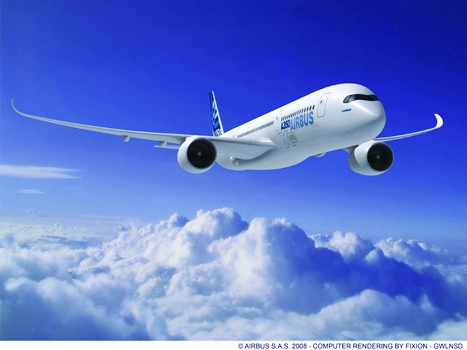Airbus Enters the Composite Class
This week, Airbus towed its newest airliner, the A350 XWB, out of the hangar and is poised to roll it into the spotlight of the upcoming Paris Air Show.
 Although its designation, which stands for 'extra-wide body,' might be lagging behind the Dreamliner's inviting branding, the A350 XWB has been designed with the goal of surpassing the 787 in fuel efficiency and comfort.
Although its designation, which stands for 'extra-wide body,' might be lagging behind the Dreamliner's inviting branding, the A350 XWB has been designed with the goal of surpassing the 787 in fuel efficiency and comfort.
The A350 will seat nine across in standard seating and eight across in the premium class. Hoping to get an edge over Boeing's Dreamliner, Airbus squeezed in chairs that are 1.3 cm wider than the Dreamliner's. And perhaps not surprisingly, this proposal was criticized for lacking ambition.
Airbus responded by announcing a program to design and build a lighter, more aerodynamic aircraft that could match the Dreamliner's claim to a 25 percent reduction in fuel consumption over its predecessor.
To meet these goals, the A350 has been designed to incorporate composite materials, just as the 787 was. However, the A350 XWB differs in the way these materials have been put to use. For example, the A350 has affixed composite panels to a composite skeleton frame to form the fuselage, while the 787 instead used composite “barrels.”
The idea (for both aircraft) is to offer a passengers a larger, more comfortable cabin environment while keeping the fuel consumption of the hefty plane to a minimum. But Airbus may have actually exceeded this goal, seating 270-440 people to the Dreamliner's 210-330, which puts the A350 in closer competition with Boeing's larger 777.
In fact, Boeing is expected to make further announcements about its updated 777, called the “777X” at the Paris Air Show, where it will also likely celebrate the Dreamliner's return to the skies following the fleet's grounding earlier this year. In light of the 787's battery meltdown problem, Airbus has opted to use the more proven nickel-cadmiun cells over the potentially volatile lithium-ion batteries.
 But putting the Dreamliner aside, what makes the A350 unique for Airbus is the way in which shifting from metal to composites has fundamentally altered the manufacturing process. In the past, using metallic parts has meant producing components that are close enough to specifications such that they can later be machined down to the final structure. With composites, on the other hand, the part must be precisely the right size from the start, which means that the precision engineering has to go into the tools that produce these parts, rather than into the parts themselves.
But putting the Dreamliner aside, what makes the A350 unique for Airbus is the way in which shifting from metal to composites has fundamentally altered the manufacturing process. In the past, using metallic parts has meant producing components that are close enough to specifications such that they can later be machined down to the final structure. With composites, on the other hand, the part must be precisely the right size from the start, which means that the precision engineering has to go into the tools that produce these parts, rather than into the parts themselves.
Full story at The Engineer










